Dr John Geddes ( 1735 – 1799 )
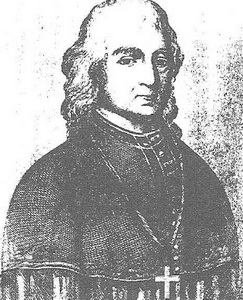
Dr John Geddes was Roman Catholic Bishop of Dunkeld, Vicar Apostolic of the Lowland District of Scotland from 1780 to 1793, and elder brother of the biblical critic Bishop Alexander Geddes. ( Were Poems attributed to Burns written by the hand of Alexander Geddes ? Visit Burns or Alexander Geddes )
John Geddes thought that Burns was “A Man of Uncommon Genius” while Burns wrote to Geddes starting “Venerable Father” This was a friendship apparently built on mutual respect. Robert Burns and John Geddes first met during the winter of 1786/87 at the house of Lord Monboddo in Edinburgh. Geddes took an interest in the poet’s work, and was responsible for getting five Catholic Seminaries, including that of the Scots College at Valladolid, of which he had once been Rector, to subscribe to the Edinburgh Edition of 1787.
Geddes was not personally one of the Subscribers to the Edinburgh Edition, but he later obtained a copy which he had rebound with blank end-papers at both the front and back. Burns borrowed Geddes’ copy during his Highland Tour, and delayed returning it for almost two years. Writing to Geddes from Ellisland on 3rd February 1789, the poet apologised for having kept the book so long, intimating that he had added some verses within its pages. Read Burns’ letter to John Geddes by visiting Letter to The Right Rev. John Geddes, Bishop of Dunkeld .
“You will see in your book, which I beg your pardon for detaining so long, that I have been turning my lyre on the banks of the Nith. Some larger poetic plans that are floating in my imagination, or partly put in execution, I shall impart to you when I have the pleasure of meeting with you…”
…..and thus one of the most unique books of Burns’ work was created; A copy of the Edinburgh Edition with handwritten notes by the Bard himself. In addition to the works listed below, Burns wrote notes within the text of the book identifying the subjects of his work who, beforehand, had remained anonymous. For example, in “Death and Doctor Hornbook” he wrote below the title that the “Doctor” was in fact “John Wilson, Schoolmaster in Tarbolton” and in the poem previously called “To W. S******, Ochiltree” Burns had written above the asterisks “Simpson”. In the poem “Tam Samson’s Elegy” on Page 148 of the Edinburgh Edition, he even added an extra verse, marking in the Text where this addition was to be placed.
The additional unpublished handwritten material which Burns added to John Geddes’ Edinburgh Edition is listed below. Click on any of the links to access the full Text .
The following poems were written by Burns in the blank pages at the front of the book
On reading in a Newspaper the death of John McLeod, Esq., brother to Miss Isabella McLeod, a particular Friend of the Author’s [ Later known as “On the Death of John McLeod, Esq.” ]
On the death of Sir J. Hunter Blair
Written on the blank leaf of my first edition, which I presented to an old sweetheart, then married – I was then on the tip-toe for Jamaica [ Later known as “Lines to an Old Sweetheart” ]
An Epitaph on a Friend [ Later known as “Epitaph on My Own Friend and my Father’s Friend, Wm. Muir In Tarbolton Mill”, also just known “Epitaph on My Own Friend” ]
The Humble Petition of Bruar Water to the noble Duke of Athol
Epistle wrote in the commencement of my Poetical Career, to Mr McAdam of Craigen-Gillan, in answer to an Obliging Letter he sent me [ Later known as “To Mr. M’Adam, Of Craigen-Gillan, In answer to an Obliging Letter he sent in the commencement of my poetic career.” ]
On the death of Robert Dundas of Arniston, Esq., late Lord President of the Court of Sessions [ Later known as “On the Death of Lord President Dundas” ]
On scaring some water-fowl in Loch Turit, a Wild Scene among the Hills of Oughtertyre [ Later known as “On scaring some water-fowl in Loch Turit” ]
Written at the Hermitage at Taymouth [ Later known as “Verses Written With A Pencil Over the Chimney-piece in the Parlour of the Inn at Kenmore, Taymouth.” ]
Written at the Fall of Fyers [ Later known as “Lines on The Fall of Fyers near Loch-Ness” ]
—
The following three poems were written by Burns in the blank pages at the back of the book
Written in Friars’ Carse Hermitage, on the banks of Nith, June 1788 [Later known as “Lines Written In Friars’-Carse Hermitage” ]
The same altered from the foregoing, December , 1788
To Robert Graham of Fintry, Esq., accompanying a request. [ Later known as “Epistle to Robert Graham, Esq. of Fintry – Requesting a Favour” ]
Burns then wrote: “The foregoing three poems are the favor of the Nithsdale Muses”
—
On the death of Dr Geddes the book, together with Burns’ letter to him, passed into the hands of his sister, Margaret Geddes, who was married to a John Hyslop, a Scots surgeon, and lived in Finsbury Square, London. On Hyslop’s death, the book passed to their daughter, also Margaret Hyslop, who gave it to the English anatomist, Dr Henry Goadly when he left England for America in 1838. This provenance is recorded in Goadly’s handwriting on the next blank page at the back of the book : “The late John Hyslop, Esq., late of Finsbury Square, London, Surgeon, married Margaret Geddes, the sister of Bishop Geddes. Late in life the Bishop visited London and staid at his sister’s house in Finsbury Square, where he felt sick and died. His book came into Mrs Hyslop’s possession, and after the decease of her husband and herself, reverted to their daughter Margaret from whom I received it in 1838. Henry Goadly”
In 1863 James Black, originally from Nairn, by then settled in Detroit and who had become friendly with Dr Goadly, bought the book from the Doctor’s widow. The book and the letter then passed into the hands of the American collector William K. Bixby, a hugely wealthy philanthropist and then President of the Burns Club of St Louis
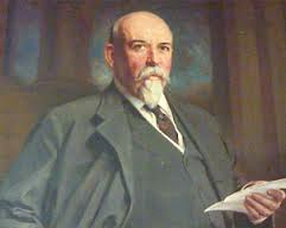
W. K. Bixby – President of the Burns Club of St Louis, 1908
In 1908, Bixby had it photographed and ‘reproduced by the lithographic and gelatine process’ in a limited edition of 473 copies. Unfortunately, he made an error in the book incorrectly attributing the original ownership to Bishop Alexander Geddes instead of his brother, Bishop John Geddes.
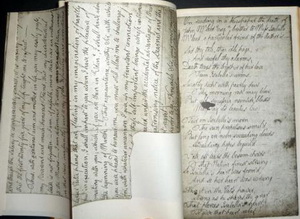
The Copies of Burns’ Handwritten Text folded into the Facsimilie Editions
The 473 copies were distributed only to the members of the Bibliophile Society of Boston, also known as The Club of Odd Volumes . This was a Gentlemen’s Club in which Members, including no less than Winston Churchill and Franklin D. Roosevelt, were referred to as “His Oddship ……….”.
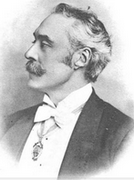
President of the Club of Odd Volumes 1894, His Oddship Alex Hollingsworth
Between running the Country and fighting wars, Churchill bred butterflies and was also an amateur bricklayer, constructing buildings and garden walls at his country home at Chartwell. As part of this hobby, Churchill joined the Amalgamated Union of Building Trade Workers but was thrown out because of his membership of the Conservative Party so, perhaps “His Oddship” was, occasionally, a fitting title.
This volume has become known as the “Geddes Burns”.
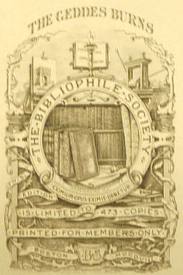
John Geddes’ original book, complete with the letter and the handwritten work of Burns, is now in the Henry E Huntington Library & Art Gallery, now just known as The Huntington, in San Marino, California.
One of the 473 copies of “The Geddes Burns” is with us here in Balerno. Any Member of ‘Let it Blaw’ wishing to view this very rare little volume is invited to contact Alex Hood.
Research is being carried out into the original ownership of our volume to see if we can explain how it travelled from Boston in 1908 all the way to Edinburgh where it was bought in a second-hand book store in Stockbridge by Jimmy Johnstone MBE.
—
The Boston Bibliophile Society OR the Club of Odd Volumes
Enquiries have been made on behalf of “Let it Blaw” in Boston relative to the Club of Odd Volumes. The organisation operated out of an upmarket and anonymous looking Town House in what was a leafy residential area of the City.
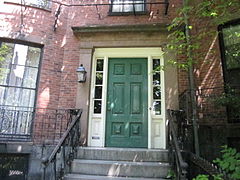 The Boston Bibliophile Society, also known as the “Club of Odd Volumes,”
The Boston Bibliophile Society, also known as the “Club of Odd Volumes,”
at what was 77 Mount Vernon Street, Boston
It appears the property, together with everything else in the same area, was sold some time ago for redevelopment and that the Club ceased to exist c.1939. While there are many records of the Club’s existence, nothing has been found to suggest the reason for its demise but, perhaps, the start of World War II had something to do with it. Who knows; perhaps it’s still in existence somewhere !
Research has unearthed the report into the Fourth Annual Banquet of the Society in 1906 at which a presentation was made to the aforementioned W. K. Bixby. This odd piece of trivia can be viewed at Harvard College Library Collection
